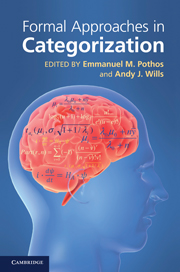Book contents
- Frontmatter
- Contents
- List of figures
- List of tables
- List of contributors
- 1 Introduction
- 2 The generalized context model: an exemplar model of classification
- 3 Prototype models of categorization: basic formulation, predictions, and limitations
- 4 COVIS
- 5 Semantics without categorization
- 6 Models of attentional learning
- 7 An elemental model of associative learning and memory
- 8 Nonparametric Bayesian models of categorization
- 9 The simplicity model of unsupervised categorization
- 10 Adaptive clustering models of categorization
- 11 Cobweb Models of Categorization and Probabilistic Concept Formation
- 12 The knowledge and resonance (KRES) model of category learning
- 13 The contribution (and drawbacks) of models to the study of concepts
- 14 Formal models of categorization: insights from cognitive neuroscience
- 15 Comments on models and categorization theories: the razor's edge
- Index
- References
7 - An elemental model of associative learning and memory
Published online by Cambridge University Press: 05 June 2012
- Frontmatter
- Contents
- List of figures
- List of tables
- List of contributors
- 1 Introduction
- 2 The generalized context model: an exemplar model of classification
- 3 Prototype models of categorization: basic formulation, predictions, and limitations
- 4 COVIS
- 5 Semantics without categorization
- 6 Models of attentional learning
- 7 An elemental model of associative learning and memory
- 8 Nonparametric Bayesian models of categorization
- 9 The simplicity model of unsupervised categorization
- 10 Adaptive clustering models of categorization
- 11 Cobweb Models of Categorization and Probabilistic Concept Formation
- 12 The knowledge and resonance (KRES) model of category learning
- 13 The contribution (and drawbacks) of models to the study of concepts
- 14 Formal models of categorization: insights from cognitive neuroscience
- 15 Comments on models and categorization theories: the razor's edge
- Index
- References
Summary
The aim of this chapter is to demonstrate that an elemental model, using a relatively simple error correcting learning algorithm, can prove remarkably resourceful when it comes to simulating human and infra-human learning and memory. The basic premise behind all elemental models of category learning is that the representation of any stimulus comprises multiple components which can individually enter into associations with designated category labels or responses. Used to its full potential, this approach captures the strengths of both prototype- and exemplar-based approaches to categorization. The full range of resources that elemental associative theories have to offer are rarely taken into account in comparisons with models that use other forms of representation, such as the configural theories offered by Pearce (1987, 1994) in the animal domain and Nosofsky (1991) in the human domain. We are by no means the only theorists to adopt this position, and the reader will find considerable overlap between our approach and that of several others (Brandon, Vogel, & Wagner, 2000; Harris, 2006; Wagner & Brandon, 2001).
We first set out the formal details of a model that implements elemental representation within an associative network employing a modified delta rule (following McClelland & Rumelhart, 1985). The modifications transform the delta rule into the basic real-time learning algorithm used by McLaren, Kaye, and Mackintosh (1989). For simplicity, some of the complexities of the latter model (e.g., weight decay and salience modulation) will not be considered here.
Information
- Type
- Chapter
- Information
- Formal Approaches in Categorization , pp. 153 - 172Publisher: Cambridge University PressPrint publication year: 2011
References
Accessibility standard: Unknown
Why this information is here
This section outlines the accessibility features of this content - including support for screen readers, full keyboard navigation and high-contrast display options. This may not be relevant for you.Accessibility Information
- 6
- Cited by
